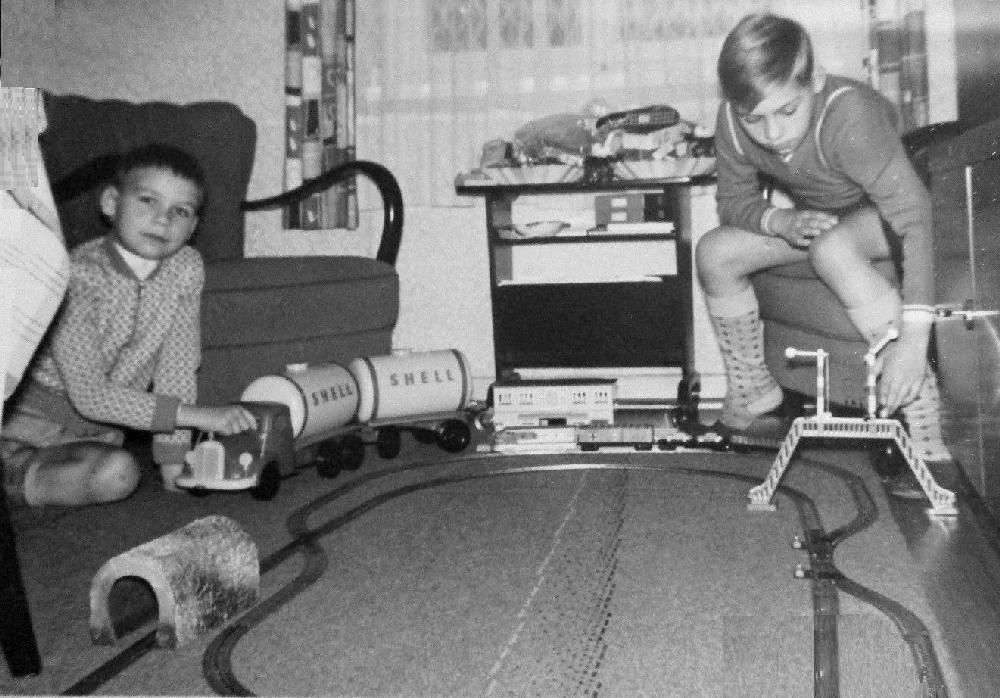
German Model Railroads: Chronology

Figure 1.--Here we see two German brothers playing with their Shell truck and electric train set. They look to be about 8-12 years old. Mom has allowed them to set up the train layout in their livingroom, presumably for the holidy. We are guessing that ghey are Christmas gifts. We are not sure how long that was tolerated, presumably a dispensatiomn for the Holidays. It is a lot of work to assembe or disassemble the track layout. There is writing on the back. We cant make out the German word--'Weihnaften'. This is observance of what in English is called Christmas Day. The word derives from a medieval German term meaning 'in the holy nights'. There are curiously no Christmas decorations. We also have the date whichh looks like 1959. It could be 1954, but 1959 is more likely.
|
|
Trains appeared in Germany during the early-19th century. There were precursors (late-1820s). The first reue railline used a British locomotive (1835). We believe toy trains appeared soon after real trains were built. We do not have much information on these early toys. here were both stand alone and pull toys. The stand alone trains could be very realistic. The pull toys were for younger boys. We begin to see images of these toys in early photographs. We have been able to find few Germasn Dags and Anbros. We do see toys as soon as CDVs appeared in the 1860s. There were all kinds kinds of different toy trains in the late-19th cntury and early-20th century. There were often mechanically driven trains. After World War I we begin to see electric trains. German maufacturers made some great ones, although export markes were disrupted by the War. The militarization of the German economy by the NAZIs in the 1930s probably affected the production of electric trains. Metal in particular was diverted to war industries. This would of course impaired thee popularity or at least children's access to them. Production of metal toys was completeklt haulted after World War II tuned aainst Germany. By the time the German economy began to recover from the War, electric trains were very popular in the post-War era. Model railroading attractd both boys and adults. The popularity of trains wain in the late-20th centuty. An important part of serious model railroading is layout contruction.
The 19th Century
Trains appeared in Germany during the early-19th century. There were precursors (late-1820s). The first reue railline used a British locomotive (1835). We believe toy trains appeared soon after real trains were built. We do not have much information on these early toys. here were both stand alone and pull toys. The stand alone trains could be very realistic. The pull toys were for younger boys. We begin to see images of these toys in early photographs. We have been able to find few Germasn Dags and Anbros. We do see toys as soon as CDVs appeared in the 1860s. There were all kinds kinds of different toy trans in the late-19th cntury and early-20th century. There were pull toys and mechanically driven trains which added interest.
The 20th Century
After World War I we begin to see electric trains. German maufacturers made some great ones, although export marktes had been disrupted by the War. We see boys building layouts. The militarization of the German economy by the NAZIs in the 1930s probably affected the production of electrical trains. Metal in particular was diverted to war industries. This would of course impaired the popularity or at least children's access to them. Production of metal toys was completeltly haulted after World War II turned against Germany and Germany finally geared up for total war. By the time the German economy began to recover from the War, electric trains were very popular in the post-War era. Model railroading attractd both boys and adults. The popularity of trains wain in the late-20th centuty. The layout is the above all the tracks, but with an added topographical and demogragrical setting. Early tains such as pull toys didn't need layouts. Most German boys, however, had only a simple circular track with a single engine. The train set here is a good example (figure 1). This of course was fine for younger boys. A very basic train was exciting enough for them. And it was something that they could build and manage which is an important part of the model train expeience. This led to a whole new toy train exoperiebce--model rail roading.
HBC

Navigate the Boys' Historical Clothing Web Site:
[Return to Main German model railroad page]
[Return to Main German toy type page]
[Return to Main toy train country page]
[Return to Main railroad page]
[Introduction]
[Activities]
[Biographies]
[Chronology]
[Clothing styles]
[Countries]
[Bibliographies]
[Contributions]
[FAQs]
[Glossaries]
[Tools]
[Boys' Clothing Home]
Created: 12:43 AM 2/15/2010
Last updated: 1:21 AM 1/8/2019



